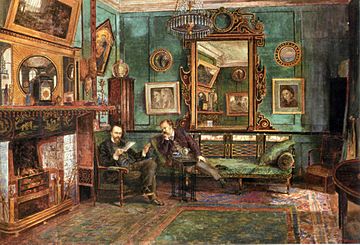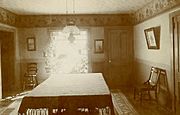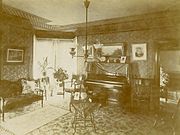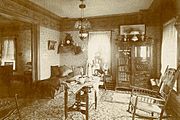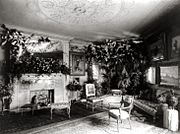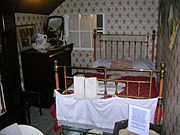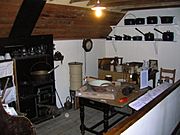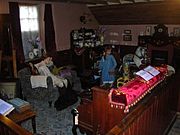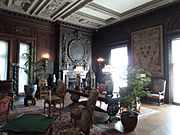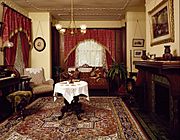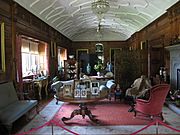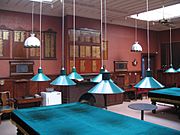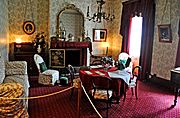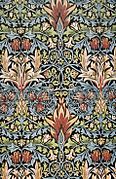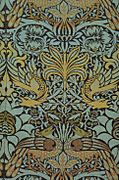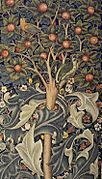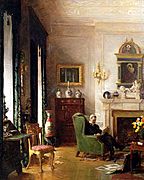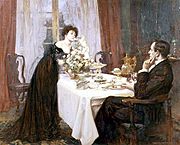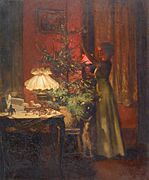Victorian decorative arts facts for kids
Victorian decorative arts refers to the style of decorative arts during the Victorian era. Victorian design is widely viewed as having indulged in a grand excess of ornament. The Victorian era is known for its interpretation and eclectic revival of historic styles mixed with the introduction of Asian and Middle Eastern influences in furniture, fittings, and interior decoration. The Arts and Crafts movement, the aesthetic movement, Anglo-Japanese style, and Art Nouveau style have their beginnings in the late Victorian era and gothic period.
Contents
Architecture
The term Victorian architecture can refer to one of a number of architectural styles that were employed in the Victorian era. This kind of architecture is named after Queen Victoria. These architectural styles include:
- Gothic Revival: examples are St Pancras railway station (1868); the rebuilt main chambers of the Houses of Parliament (1850 to 1870); Natural History Museum.
- Buildings made possible by new technology. The obvious example being the Crystal Palace (1851), which used cast iron and glass as its main elements. See Covent Garden and many provincial markets for the same method of construction.
- Completely different was the Arts and Crafts movement, which aimed at human-scale buildings based on traditional styles. It had effect in some of the new towns built in the late 19th to early 20th century in Britain.
Interior decoration and design
Interior decoration and interior design of the Victorian era are noted for orderliness and ornamentation. A house from this period was idealistically divided in rooms, with public and private space carefully separated. A bare room was considered to be in poor taste, so every surface was filled with objects that reflected the owner's interests and aspirations.
The parlour was the most important room in a home and was the showcase for the homeowners where guests were entertained. The dining room was the second-most important room in the house. The sideboard was most often the focal point, which attracts visitor’s eyes immediately when they go into a room or space, of the dining room and very ornately decorated.
Old interiors
-
Victorianparlor.jpg
Parlor in a New York House from the 1850s.
-
The parlor of the Whittemore House 1526 New Hampshire Avenue, Dupont Circle, Washington, D.C
Preserved interiors, private spaces
-
1890s Bedroom, James A. Garfield National Historic Site
-
Victorian bedroom exhibition, Dalgarven Mill, Ayrshire
Preserved interiors, public spaces
-
Vanderbilt Mansion, living room
-
1879, parlor of Emlen Physick Estate, 1048 Washington Street, New Jersey
Walls and ceilings
The choice of paint color on the walls in Victorian homes was said to be based on the use of the room. Hallways that were in the entry hall and the stair halls were painted a somber gray so as not to compete with the surrounding rooms. Most people marbleized the walls or the woodwork. Also on walls it was common to score into wet plaster to make it resemble blocks of stone. Finishes that were either marbleized or grained were frequently found on doors and woodwork. "Graining" was meant to imitate woods of higher quality that were more difficult to work. There were specific rules for interior color choice and placement. The theory of “harmony by analogy” was to use the colors that lay next to each other on the color wheel. And the second was the “harmony by contrast” that was to use the colors that were opposite of one another on the color wheel. There was a favored tripartite wall that included a dado or wainscoting at the bottom, a field in the middle and a frieze or cornice at the top. This was popular into the 20th century. Frederick Walton who created linoleum in 1863 created the process for embossing semi-liquid linseed oil, backed with waterproofed paper or canvas. It was called Lincrusta and was applied much like wallpaper. This process made it easy to then go over the oil and make it resemble wood or different types of leather. On the ceilings that were 8–14 feet the color was tinted three shades lighter than the color that was on the walls and usually had a high quality of ornamentation because decorated ceilings were favored.
Wallpaper
Wallpaper and wallcoverings became accessible for increasing numbers of householders with their wide range of designs and varying costs. This was due to the introduction of mass production techniques and, in England, the repeal in 1836 of the Wallpaper tax introduced in 1712.
Wallpaper was often made in elaborate floral patterns with primary colors (red, blue, and yellow) in the backgrounds and overprinted with colours of cream and tan. This was followed by Gothic art inspired papers in earth tones with stylized leaf and floral patterns. William Morris was one of the most influential designers of wallpaper and fabrics during the latter half of the Victorian period. Morris was inspired and used Medieval and Gothic tapestries in his work. Embossed paper were used on ceilings and friezes.
-
Artichoke wallpaper, by John Henry Dearle for Morris & Co., circa 1897 (Victoria and Albert Museum).
Furniture
There was not one dominant style of furniture in the Victorian period. Designers rather used and modified many styles taken from various time periods in history like Gothic, Tudor, Elizabethan, English Rococo, Neoclassical and others. The Gothic and Rococo revival style were the most common styles to be seen in furniture during this time in history.
Oscar Wilde's aesthetic of Victorian decoration
Chief among the literary practitioners of decorative aestheticism was Oscar Wilde, who advocated Victorian decorative individualism in speech, fiction, and essay-form. Wilde’s notion of cultural enlightenment through visual cues echoes that of Alexander von Humboldt who maintained that imagination was not the Romantic figment of scarcity and mystery but rather something anyone could begin to develop with other methods, including organic elements in pteridomania.
By changing one’s immediate dwelling quarters, one changed one’s mind as well; Wilde believed that the way forward in cosmopolitanism began with as a means eclipse the societally mundane, and that such guidance would be found not in books or classrooms, but through a lived Platonic epistemology. An aesthetic shift in the home’s Victorian decorative arts reached its highest outcome in the literal transformation of the individual into cosmopolitan, as Wilde was regarded and noted among others in his tour of America.
For Wilde, however, the inner meaning of Victorian decorative arts is fourfold: one must first reconstruct one’s inside so as to grasp what is outside in terms of both living quarters and mind, whilst hearkening back to von Humboldt on the way to Plato so as to be immersed in contemporaneous cosmopolitanism, thereby in the ideal state becoming oneself admirably aesthetical.
See also
- Victorian fashion
- Victoriana
- Eastlake movement
- French polish
- Neo-Victorian
- Pteridomania
- Staffordshire dog figurine
- Hand cooler
- Charles Eastlake
- Augustus Pugin
- William Morris wallpaper designs


